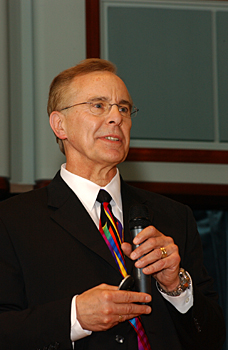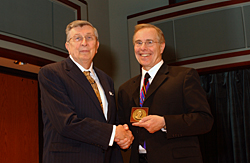
3:15 p.m., April 6, 2007--The development of solar energy as a major source of electrical power is now at a critical stage and the U.S. is positioned to play a significant role in the process, thanks to increased funding and a new government initiative announced by President George W. Bush, Lawrence L. Kazmerski, director of the U.S. Department of Energy's National Center for Photovoltaics (NCPV) at the National Renewable Energy Laboratory (NREL) in Golden, Colo., said during a lecture at UD on Thursday, April 5.
Kazmerski gave the lecture, “It's Not Your Father's Solar Anymore,” after he received the 2007 Karl Böer Solar Energy Medal of Merit in Gore Recital Hall in the Center for the Arts. The award is given in honor of Karl Wolfgang Böer, Distinguished Professor Emeritus of Physics and Solar Energy at UD and founder of UD's Institute of Energy Conversion (IEC).
The bronze medal and a cash award of $40,000, funded by the Karl W. Böer Solar Energy Medal of Merit Trust, is given every two years to an individual who has made significant pioneering contributions to the promotion of solar energy as an alternate source of energy through research, development or economic enterprise or to an individual who has made extraordinarily valuable and enduring contributions to the field of solar energy in other ways.
Kazmerski said the Solar America Initiative, which was announced last month by the U.S. Department of Energy with the aim of accelerating widespread commercialization of clean solar energy technologies by 2015 to give the United States additional electricity supply options while reducing dependence on fossil fuels and improving the environment, was a major turning point.
“I look at it this way: It's kind of like Nixon going to China,” Kazmerski said. “A lot of people would not associate President Bush with renewable energy and anything like this, but he did make this initiative, part of which is in solar.”
Kazmerski said the new initiative has “fairly aggressive goals and puts us on the path for the Unites States to be a major player” in the development of affordable solar energy technology. He added that along with the initiative, federal government funding for solar technology development, which had dwindled sharply over two decades, rose to $139 million last year, matching the level of funding last attained in 1982.
UD scientists at IEC, who are conducting research in four of 13 industry-led solar technology development projects in the initiative, will be working on projects led by General Electric, Dow Chemical, Konarka and Miasole. The institute will receive funding of $350,000 the first year, and up to $1 million over a three-year period contingent upon the teams meeting their stated goals at the end of the first and second years of the project.
“Photovoltaics is at a tipping point and right now it's at a very critical stage [in] what happens and how fast this technology disseminates, and that's why it's very important for a place like IEC, which has been at the foundation of things, to keep on, and the University of Delaware to keep on, and other universities to keep on, because we have many needs, not only for the research side, but also there is a huge need for developing the workforce for this technology,” Kazmerski said. “Photovoltaics now have fairly good high-paying jobs.”
Kazmerski announced that he would donate the money from his award to start a program that would enable students from UD and other universities to conduct research at NREL as one way to boost human resource development in the field of solar technology.
Kazmerski praised Böer, who attended the ceremony and lecture, for his pioneering work and foresight, which have become critical pillars of the development of solar power technology. “Where we are is great, but we can't forget what got us here, and also we should not neglect the strengths in our future,” he said.

UD President David P. Roselle said the first Karl W. Böer Solar Energy Medal of Merit was presented in 1993 to former U.S. President Jimmy Carter. “He was cited as the individual who, more than anyone else, spurred development and focused world attention on the relatively unknown technology for safe and environmentally sound energy production from the sun. Larry Kazmerski is the eighth recipient of the Karl W. Böer Solar Energy Medal of Merit Award and we are pleased to have him join the distinguished group of recipients,” he said.
Kazmerski, who was named director of NREL's NCPV in 1999, was the first research staff member in photovoltaics at NREL, then the Solar Energy Research Institute (SERI). He has a doctorate in electrical engineering from the University of Notre Dame and was on the faculty of the University of Maine before joining SERI in 1977. He has been an adjunct professor at the University of Colorado, Colorado School of Mines and the University of Denver.
Kazmerski has published more than 300 journal papers and delivered nearly that many lectures on solar cells, thin films, semiconductor materials and devices, surface and interface analysis, scanning probe microscopy, nanoscale technology, high-temperature superconductivity and semiconductor defects. An author and editor of four books, he is editor-in-chief of the Elsevier journal, Renewable and Sustainable Energy Reviews. He also has led efforts to document via video and exhibits the contributions of solar energy pioneers and organizations over the past half century so they will not be lost to those who follow in their footsteps.
Kazmerski is a member of the National Academy of Engineering. He is a fellow of the Institute of Electrical and Electronic Engineers, a fellow of the American Physical Society and a fellow of the AVS Society for Science and Technology. He has received several recognitions for his research and technical leadership, including the AVS Peter Mark Award, the Nelson W. Taylor Award for Materials Science from Pennsylvania State University and the World Photovoltaics Award.
He has received three R&D 100 Awards for the development of methods and instruments that characterize the electro-optical, chemical and structural properties of materials at the micro- and atomic-scales.
Other recipients of the Böer medal include:
- 1995, David E. Carlson, vice president of the Thin Film Division of Solarex, an AMOCO subsidiary;
- 1997, Adolf Goetzberger, founder of the Fraunhofer Institute for Solar Energy Systems;
- 1999, Stanford R. Ovshinsky, a pioneer in the science of amorphous semiconductors resulting in the development of low-cost, thin-film silicon solar cells;
- 2001, Allen M. Barnett, a pioneer in high-performance, thin-crystalline silicon solar cells and currently research professor in UD's Department of Electrical and Computer Engineering;
- 2003, Martin A. Green, Inaugural Scientia Professor at the Centre for Photovoltaic Engineering in Sydney, Australia, and foundation director for the Centre for Third Generation University of New South Wales in Sydney; and
- 2005, Yoshihiro Hamakawa, adviser professor to the chancellor at Ritsumeikan University in Shiga, Japan, and a prominent scholar in the field of solar photovoltaic energy.
Article by Martin Mbugua
Photos by Duane Perry


